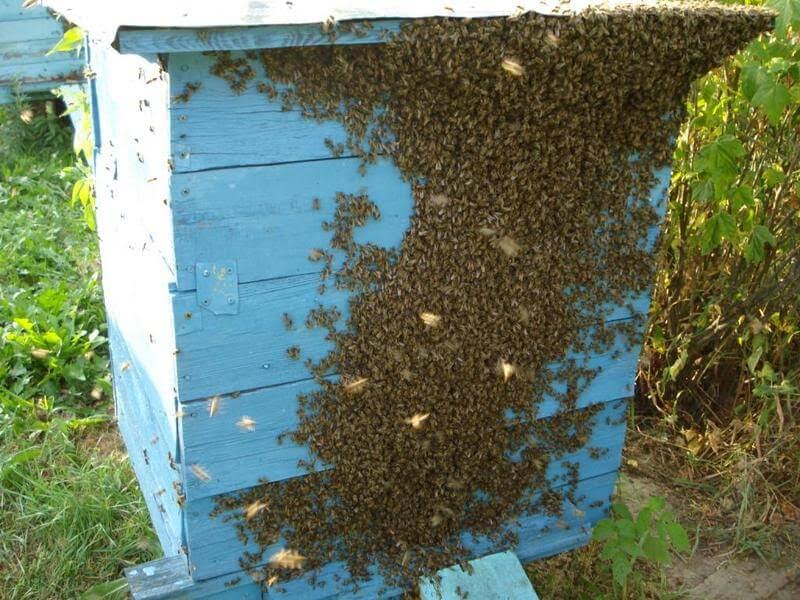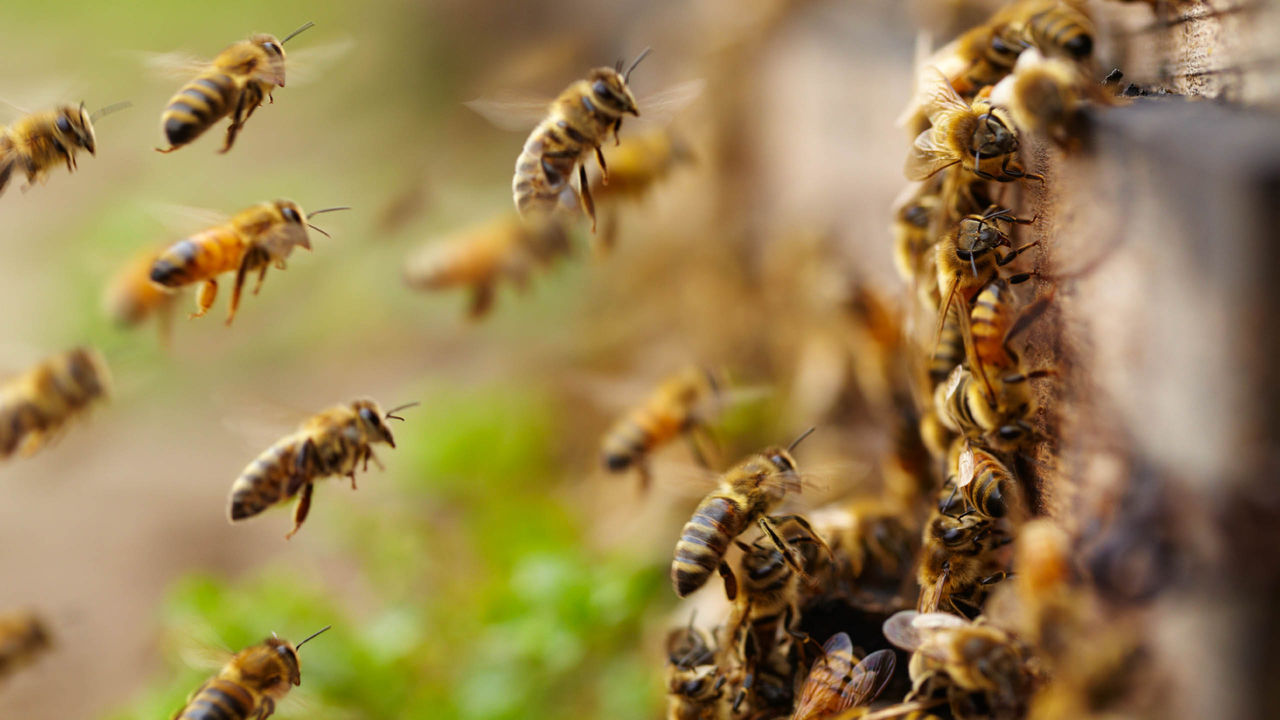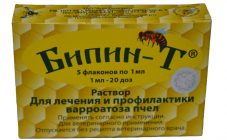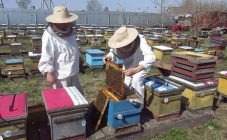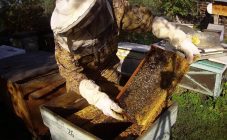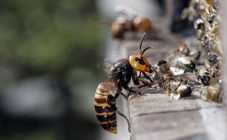Content:
The key event in the life processes of bees is the swarming process. Understanding the features of the process will allow for preventive measures to prevent it. When certain conditions occur, the bee colony is divided into two parts. One of the formed parts remains in the hive, the second leaves it. This process is called swarming.
Outwardly, the spectacle looks like a stream of bees formed into a dense cloud. The average weight of one swarm varies within 1.5 kg, however, in nature, larger swarms (up to 5 kg) have been recorded. A bee swarm sits on a shrub or tree, waiting in this form for scouting bees, rushing to find a new home. With a favorable outcome of exploration, the swarm will be redeployed to a new nest.
The swarming process is usually a criterion for the well-being of bees. However, relocation can also be induced by unfavorable conditions. In addition, swarming can be triggered by the actions of beekeepers. Scientists have developed methods to prevent swarming and keep workers active.
Signs and Causes
Typical signs of the early onset of the swarming process are:
- cessation of the supply of nutrients to the uterus;
- a decrease in the size of the uterus, it begins to acquire the ability to fly;
- a sharp decrease in the laying of eggs by the uterus;
- cessation of nectar extraction by bees;
- the formation of large clusters of insects on the walls of the hives;
- stopping the construction of honeycombs;
- there is an abundant breeding of drones;
- insects gnaw through the entrances;
- increased disturbance of bees.
In addition to the listed reasons, the occurrence of a swarm state can also be caused by:
- cramped hive and lack of work for a large part of the family;
- the presence of a good bribe, but no storage space;
- overheating of the hive by the sun's rays;
- the presence of an old queen, unable to maintain the rate of laying eggs, thereby forming an imbalance in the number of feeding bees and larvae.
The threat of loss of bee colonies and a decrease in honey collection processes negatively affect the overall productivity of the beekeeping farm and in the long term threaten with losses for the maintenance of a weakened family in winter. Swarming can continue for a long time, forming weaker swarms with each division of the family. In this regard, preventing the formation of swarms becomes an acute problem.
Why bees swarm during honey collection
Signs of the beginning of the swarming of a bee colony during the period of honey collection is a strong growth of the population of individuals.
The bees left without load start building queen cells. At the end of their sealing, the old uterus leaves the nest with the swarm.
Swarming Prevention Measures
Measures to prevent and form swarms of bees are based on biological processes inside the hive. Measures to prevent swarming of bees in an apiary are often actions that lead to an increase in the workload of bees. When a small bribe appears, you should increase the free space of the nest and put additional frames with foundation.In this case, young bees will be aimed at building combs and feeding larvae.
In the second half of May, subject to normal conditions of detention, shops and second tiers should be installed in standard hives, and the following body elements are installed in multi-hive hives. When installing additional housings, special attention must be paid to the insulation of the hives from above.
An old and proven method to prevent unwanted migration is by clipping the wings of the uterus. This procedure allows you to additionally determine her age. For convenience, in an odd year, one of the wings is trimmed, in an even year, the remaining one. It is enough to remove one third of the wing, with such wings the uterus is no longer able to fly, and the process of swarm formation that has begun ends.
When using a multi-body hive, it is possible to transport all brood to the upper tier, except for the frame with the queen. The entrance of the first compartment must be fenced off with a grate. In the upper part of the hive, additional honeycombs need to be installed, in the lower - foundation. Insects will start building foundation, having contact with the uterus. After 1-2 weeks, the swarm mood will subside and the frame can be removed.
Transferring the sealed brood to the upper body of the multi-hive is one of the reliable methods to prevent swarming of bees. Leaving the queen with an open brood in the lower tier, you need to fill the vacant space with honeycombs and foundation. Such a procedure to avoid colony overpopulation will preserve the activity of bees, free space for egg-laying, and worker bees for nectar. After filling the upper body with honey, it is recommended to place a magazine on top.
Distributing the bees by rearranging the hives will prevent swarming. The hive with the swarm must be rearranged to a remote place, installing a clean one in its place. It should include 6-8 frames with foundation, two of which should be filled with sweet syrup. Bee clutch should be placed in the center of the hive.
Such activities should be carried out before the swarm separates. On the new hive, on top, you need to put a plywood frame with a diaphragm, where you should build a notch that absolutely coincides with the old one.
An old hive must be placed on the frame to move the bees into a new one. In the new hive, bees will begin to lay fresh fistula queen cells, thereby preventing swarming. Families can be reunited during the period of active honey collection and clutching by both queens.
In a quiet time of the day (preferably in the evening), families in both hives should be sprinkled with sugar water infused with mint. The upper part of the diaphragm composite hive must be removed. Lay the newspaper with the prepared perforation on the frames and install the hive on top, but remove the diaphragm. In the lower hive it is necessary to open the upper entrance. During the night, the families will be united, and at the peak of the honey harvest, the entire bee colony will be included in the work.
Developed by Walter Wright, a Canadian expert, the method is called "chess". Above the nest, before swarming, it is necessary to stagger the frames with honeycombs and sealed brood. This method is popular because no disturbance measures are required for the bees. This method affects the orientation of individuals, knocking them out of swarming intentions.
Bee swarming periods
The time when bees swarm can vary within the same climatic zone from year to year. It depends on weather conditions, availability and abundance of honey plants.
In the southern regions, active swarming can be observed as early as May. In the conditions of central Russia, swarming mother liquors are laid in early June, ending swarming by the end of the month.
In the northern regions at the end of June, the prerequisites for the formation of a swarm may only begin to be laid.
July is the month in which active natural swarming of bees most often occurs in the middle lane. In the regions of the north, the swarming process ends by early July.
The latest swarms in the middle lane
The latest swarms of bees are observed in the middle zone at the end of August. The main bribe takes place in the last summer month. A rare pumping of honey from the honeycomb provokes a decrease in flight activity, and a swarm of bees is formed. Reduction of uterine cervix reduces the stress of the nurse bees by stimulating the swarming process.
Artificial swarming of bees
Artificial swarming is the process of increasing the number of families in an apiary. In addition, such a process is a measure to prevent spontaneous swarming. This event is based on the breeding of a new queen and the formation of a new colony in the part of the bees left after separation. To speed up the process of stabilizing the new family, you can give the remaining part a pre-prepared uterus.
Artificial swarming allows breeding work leading to an increase in the productivity of bee families. In addition, swarming control allows, in accordance with the schedule, to carry out work in the apiary. Early dates of artificial swarming can increase the gross honey harvest.
This time will be enough to rebuild a new family and strengthen the main bribe by the time.
Crushing just before the bribe will weaken the family and the swarm. She will not be able to secure her forage reserves for the winter. Therefore, in addition to loss of income, it will bring losses, since it will need to be provided with honey for wintering and spring development.
The timing of the separation of bee colonies depends on the timing of raising the queens and the accumulation of a sufficient mass of the population of the hive. If it is possible to acquire early queens, the time of the beginning of artificial swarming will depend only on the rate of accumulation of family strength.
The advantage of this method is to increase the activity of the bees. In addition, unlike natural swarming, artificial swarming shortens the period of inactivity of bees. In addition, by removing the fetal queen in advance, the beekeeper shortens the period of inactivity of the feeding bees. An increase in bee colonies without prejudice to the honey harvesting process has a beneficial effect on the overall profit of the apiary.
How to plant a swarm in a hive
What to do if a swarm of bees arrives? Before replanting the swarm, it is required to equip and prepare the hive in advance. Inside there should be frames with stretched foundation and separately with unsealed brood and feed base.
Installing a frame with brood will allow you to avoid leaving the new home in a swarm, honey is needed in case of adverse natural phenomena to provide bees with nectar. The number of frames is calculated according to the scheme 3-4 frames per 1 kg of bees. The frames with honey should be set alternating with frames with brood.
To collect a swarm grafted to a tree trunk, you can use a scoop, a wooden spoon, or a box covered with a canvas. For sampling the uterus, you should choose the most heaped place. After transporting the uterus into a box installed next to the swarm, it must be covered with a canvas, forming an opening for departure. The rest of the individuals in the scion must be disturbed with smoke, after which, following the queen, the bees fly over.
To transplant bees into the hive, the correct solution is to wait until dusk. In the evening, you should open the canvas in the hive and transfer the bees from the temporary shelter in the form of a box.After that, you need to close the hive and insulate it.
By placing the box next to the makeshift ladder, place a few bees on the taphole with a wooden spoon. Slowly pour other individuals onto the gangway at a distance of 50-70 cm from the entrance. Individuals in the taphole with a characteristic sound will inform the others about finding a suitable dwelling. After that, the rest of the swarm will begin to crawl into the hive. At this time, additional help in identifying the uterus will not be required, and its removal will not be difficult.
Observation an hour after the transfer of departing individuals, starting to take out garbage, etc., means that the settlers have begun to improve their housing. Quiet behavior without departures signals inappropriate conditions and the imminent departure of the swarm.
The reasons that caused rejection among the bees may be poor quality materials of the hive. Used ceilings can smell unpleasant for bees. Unsuitable for a hive under construction are boxes of soap, medicines, perfumes or chemical reagents. The use of natural pure wood processing products will eliminate this risk factor.
In addition, the odor produced by the canvas can also cause rejection in the swarm. Good washing and drying will reduce the risk of leaving your new home. Poor hive insulation and drafts also increase the possibility of swarm rejection.
Summing up, we can say that the swarming process is a natural method of separating bee colonies. It can be caused by overpopulation of the hive, adverse conditions, or by the actions of the beekeeper. After that, a weakened family remains, unable to maintain the required level of honey collection, which will lead to losses in beekeeping. In addition, the division process taking place in this way can be repeated several times, leaving the family composition less and less adapted to wintering conditions. Carrying out preventive measures or artificial swarming will help increase the activity of bees, bringing additional income.


